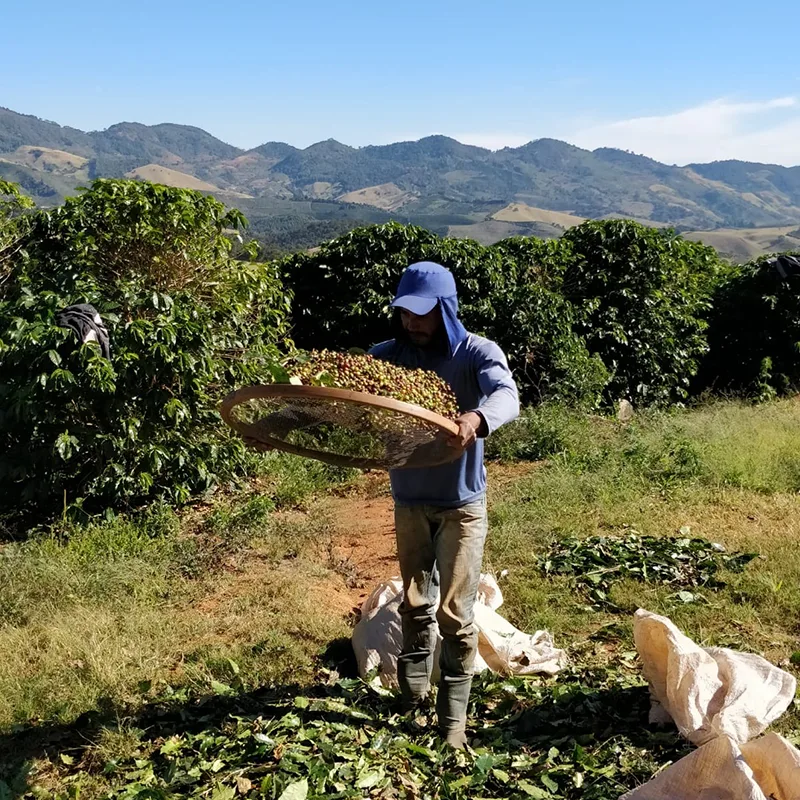All coffee grows in the tropics, within the Tropic of Cancer and the Tropic of Capricorn in Ideal temperature from 7 to 32C. Many coffee growing areas do not meet this “perfection”. Higher Altitude brings floral, fresh berry and citrus flavours, following nutty and earthy flavours in lower altitude. Altitude has a powerful effect on a coffee’s flavour profile.
Beans growing at lower levels tend to lose their flavour more quickly. Terroir – the term once reserved exclusively for wine including quality soil ,plays crucial role in producing a high quality coffee. There are four primary methods of processing speciality greens. Wet/Washed, Dry/Naturals , Pulped /Natural (Honey). Each method affects the coffee bean in a different way and also gives direction of the roasting profile.
NATURALLY PROCESSED – is a relatively straightforward process, as all its layers are left intact. Fruit is send on raised beds for drying where can spent weeks. Care must be taken to avoid mould and rot. After the fruit is fully dried, its dark, shrivelled from must then be hulled (peeled) to reveal the beans patiently waiting inside. Brazil is home of naturally processed coffee especially at Sao Paolo and Cerrado region where naturals take 90 per cent of their coffee. Naturally processed coffee is non interventional, self-contained and natural which gives the resulting coffee its dirty heavy and wild with accentuated fruity notes. Capricious brilliance of dry processed coffee can yield inconsistent results, however, and clarity of the cup can be lost. But what it lost in finesse can be made up in body and density.
WASHED COFFEE – also known as wet processed coffee, sees the whole cherry get pulped, either mechanically or by a high pressure water. Either way the cherry is split, and squeezed forcing the beans though a separate aperture. Pulping deals only with the soft flesh of the cherry – there is still mucilage that coats the bean. The tenacity of mucilage is attributed mostly to its combination of sugars and pectin. Removal of the mucilage is done by fermentation although fermentation is not just about removing the mucilage, it’s also exercise in coffee flavour development and when timed well can produce high level of clean acidity. After some washing to remove any excess mucilage, the beans are sent for drying on raised beds, of concrete floors, for around the week. Although the wet processing has a good reputation the fermentation can be unpredictable as it relies solely on micro-organisms that are present in the fruit itself or in the water. Defective beans are not uncommon. There are also many variations of wet processing in different countries and regions.
The decision to choose dry or wet process is mostly one of economics. Wet process is widely considered as a superior but it requires huge quantities of water, numerous tanks, decent plumbing and other specialist equipment.
PULPED NATURAL COFFEE – also known as honey processed coffee or semi washed, is combination of natural and wet processing techniques. It combines the economic benefits of natural process with speed of the washed process. The result is better body then some washed coffees have and more clean and crisp character then those found in natural processing. The process starts like in wet processing: the coffee is pulped first to remove the skin and flesh, like in washed coffee, the mucilage remains attached to the seed but instead of being sent to fermenting tanks for removal, the beans skip straight to the drying phase. Drying of honeys is a bit challenging because the moist and sticky environment is perfect for rot and decay. Coffee is dried on raised beds ranked over large patios in a process that takes one or two weeks. The farm can choose to remove some or most of the mucilage before the drying, which speeds things up more. It gives the bean more colour and takes the character of the coffee in the direction of a washed one. Amount of mucilage left on the seed is important for the final character of the coffee. ‘Black honeys’ retains most of the mucilage before drying, ‘red honeys’ removes some and ‘yellow honey’ removes all or almost all of it.
DRYING – the main purpose of drying the coffee after processing is to reduce the moisture of the bean from 40% to around 10 – 12%. There are numerous drying methods from oldest and simplest like patios to raised beds in Africa, tarpaulin in Nicaragua and Sumatra and so on. The general rule is to reduce the drying rate near the end of the process.
CLIMATE CONDITIONS AND THE COFFEE QUALITY – Arabica and Canephora natural habitat is in the shades of tropical forests. Simulating this environment in agronomic systems favors coffee quality. Ideal climate for highest quality arabica is constant humidity (26%) , temperature in warmest month max. 25C and minimal in coldest month 13C with high annual precipitation (>2600 mm) and short dry season (elevation 1570m). Among all the climatic factors, the average air temperature during bean development strongly influences the sensory profile.
